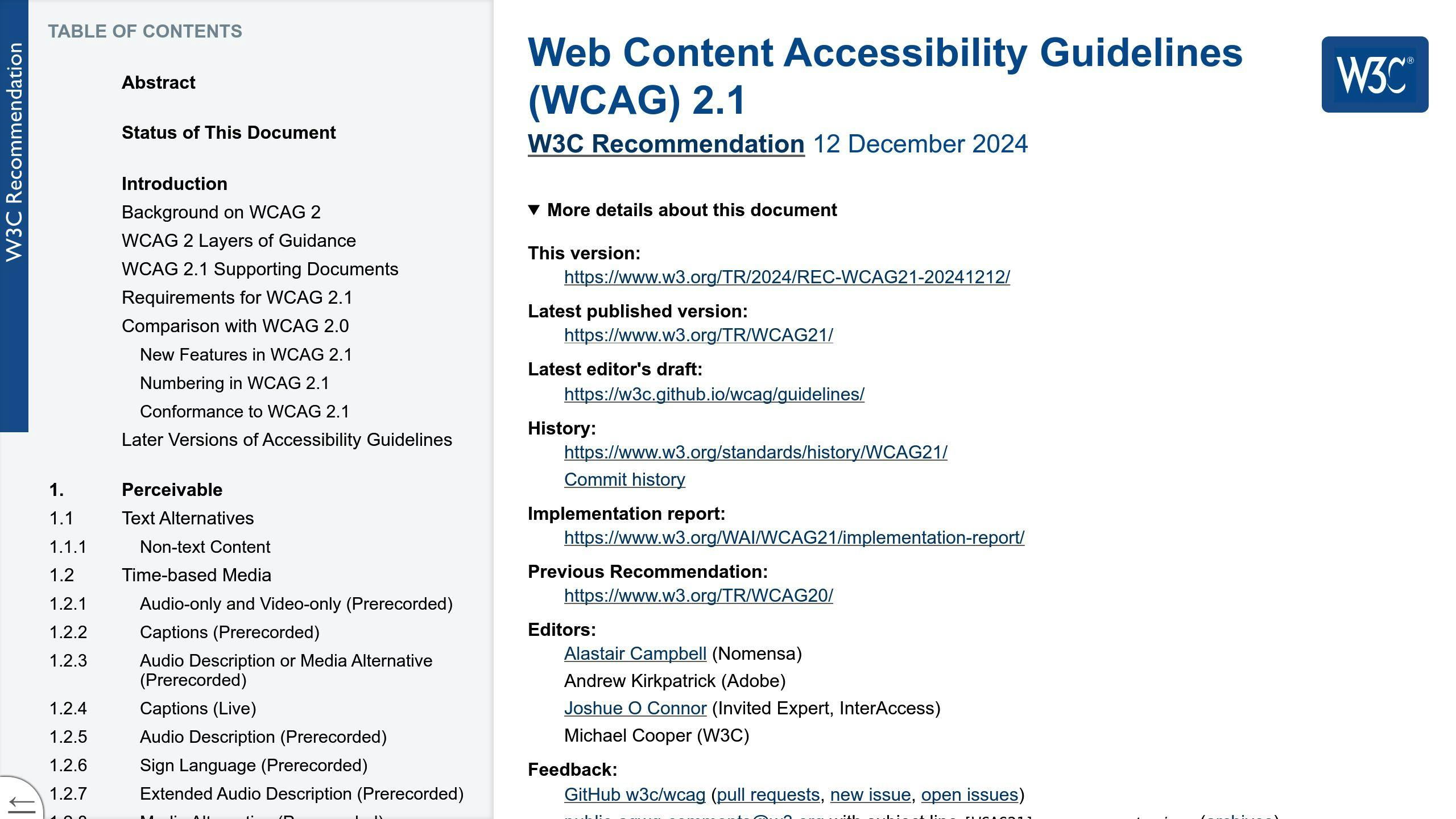Creating accessible emails isn't just about compliance anymore - it ensures everyone can engage with your content. In 2025, following accessibility standards like WCAG 2.2 and ADA helps improve usability, expand your audience, and avoid legal risks. Accessible emails are easier to read, navigate, and interact with, benefiting all users, including those relying on assistive technologies.
Key Takeaways:
- Text & Color: Use readable fonts (14px+), maintain a 4.5:1 contrast ratio, and provide clear alt text for images.
- Keyboard Navigation: Ensure all interactive elements work without a mouse and follow logical tab order.
- Interactive Features: Include alternatives for gestures (e.g., arrow keys for swiping) and test compatibility across devices.
- Testing Tools: Use screen readers (JAWS, NVDA), automated checkers (WAVE, axe), and manual reviews for thorough testing.
- Compliance Checklist: Follow WCAG 2.2 AA standards, like visible focus indicators and minimum target sizes (24x24px).
Accessible emails create better experiences for everyone while meeting legal requirements. Start by designing with inclusivity in mind, testing thoroughly, and staying updated with evolving standards.
Email Accessibility - Design & Code
Making Interactive Emails Accessible
Interactive emails should align with WCAG and ADA standards to ensure they are usable by everyone, including those relying on assistive technologies.
Text and Color Standards
To ensure readability, use a minimum font size of 14px for body text and 18px or larger for headings. Pair these with high-contrast color combinations, such as dark gray (#333333) on white. For fonts, stick to clean, sans-serif styles that remain easy to read at different sizes.
| Element | Minimum Requirements |
|---|---|
| Body Text | 14px size, 4.5:1 contrast |
| Headings | 18px size, 4.5:1 contrast |
| Interactive Elements | Clear hover/focus states |
Keyboard Controls
Many users depend on keyboards or assistive devices to navigate. Make sure all interactive elements are fully functional without a mouse. Arrange elements in a logical tab order, provide visible focus indicators (like 3px borders), and include skip links to let users bypass repetitive navigation tasks [2].
Image Alt Text Best Practices
Alt text should provide meaningful context that explains the image's purpose. For example, for product images, write descriptions like: "Red Nike running shoes with white swoosh, model Air Zoom." For icons, specify their function, such as: "Download 2025 Accessibility Report (PDF, 2.2MB)."
"Accessibility in email design and content ensures that all users, regardless of their abilities, can effectively receive and interpret the information being conveyed." [2]
Code and Tools for Accessibility
Using ARIA in Emails
ARIA roles and attributes can improve how assistive technologies interpret dynamic email content. Here are a few examples of how to use them:
| ARIA Attribute | Example Usage |
|---|---|
| aria-label | <button aria-label="Subscribe to newsletter"> (explains the button's purpose) |
| aria-expanded | <div aria-expanded="false"> (indicates whether content is expanded or collapsed) |
| aria-hidden | <div aria-hidden="true"> (hides non-essential decorative elements) |
Be cautious not to assign ARIA roles to elements that already have built-in semantics, like adding role="button" to a <button> tag. This can confuse screen readers and lead to redundancy.
While ARIA can improve accessibility, it’s equally important to ensure your email works consistently across different email clients to deliver a smooth experience for all users.
Email Client Compatibility
Accessibility in email design depends heavily on ensuring compatibility across various email clients. This allows all users, regardless of their platform, to engage with your content effectively. A good approach is to offer a basic version of content for all clients and layer advanced features for those that support them.
For instance, if you're designing an interactive carousel, include a fallback static image for email clients that don’t support JavaScript. This ensures that every recipient can still access the core message of your email.
Once your design is in place, thorough testing across devices and platforms is essential to confirm it meets accessibility standards.
Testing with Assistive Tools
Testing is critical to ensure your emails are accessible. Use a combination of tools to evaluate your content:
| Tool Type | Example Tools |
|---|---|
| Screen Readers | JAWS, NVDA, VoiceOver (to check how content is read aloud) |
| Automated Checkers | Lighthouse, WAVE, axe DevTools (to validate your code) |
| Keyboard Navigation | Browser tools (to test how users interact with elements using a keyboard) |
Test tab order and focus indicators with browser developer tools to confirm smooth keyboard navigation. Check how dynamic content is announced by screen readers and verify that ARIA attributes are functioning as intended. This will help you identify and fix any gaps in the semantic structure of your email.
Cross-Device Email Accessibility
Making emails accessible across devices is essential for meeting WCAG and ADA standards while ensuring a smooth experience for all users. Modern email design must adapt to different screen sizes and usage contexts without compromising usability.
Responsive Design Guidelines
Creating a structure that works well on any screen size involves focusing on key design elements:
| Design Element | Best Practice | Why It Matters |
|---|---|---|
| Layout Structure | Use relative units like % or em |
Keeps content properly scaled |
| Buttons & Spacing | Ensure buttons are at least 44x44px with 8px spacing | Reduces accidental clicks |
| Content Flow | Adjust content to resize and rearrange based on the viewport | Avoids horizontal scrolling |
Mobile Touch Controls
Interactive elements on mobile devices should be easy to use without requiring precise taps. To achieve this:
- Keep at least 16px spacing between clickable elements.
- Provide clear visual feedback for any interaction.
- Position key controls in the thumb-friendly zone for easier access.
Alternatives for Motion Controls
Not everyone can use gesture-based controls, so offering alternative methods is crucial. Here’s how to make interactions more inclusive:
| Control Type | Alternative Option |
|---|---|
| Swipe Gestures | Allow navigation using arrow keys |
| Touch Scrolling | Enable Page Up/Down keyboard controls |
Thorough testing ensures these features meet accessibility standards. Screen readers should accurately announce all interactive elements and their states, while keyboard navigation must follow a logical order throughout the email content.
Testing and Standards Compliance
Ensuring accessibility in interactive emails involves a mix of automated tools and manual checks. With WCAG 2.2 introducing nine new success criteria, thorough testing is crucial for creating inclusive email experiences.
WCAG 2.2 AA Checklist

Here are some key accessibility requirements for interactive email elements:
| Criterion | Requirement | Implementation |
|---|---|---|
| Focus Visibility | 2.4.11 Focus Not Obscured (AA) | Ensure focus indicators are clear and visible |
| Target Size | 2.5.8 Target Size (Minimum) (AA) | Use interactive elements that are at least 24x24 CSS pixels |
| Authentication | 3.3.8 Accessible Authentication (AA) | Provide alternatives to cognitive-based tests |
| Dragging | 2.5.7 Dragging Movements (AA) | Offer options other than drag-and-drop actions |
Testing Methods
A three-step approach can help ensure accessibility compliance:
-
Automated Testing
Use tools like WAVE to identify technical violations. Focus on WCAG 2.2 criteria such as focus visibility and target size. Document and fix any issues flagged during this process. -
Manual Review
Test emails with popular screen readers like NVDA, VoiceOver, JAWS, and TalkBack. This helps confirm that content is easy to navigate and understand. -
Cross-platform Verification
Check emails across different clients and devices to ensure accessibility is consistent. Despite 57% of marketers considering accessibility, only 14% use proper testing tools [2].
Maintaining Accessibility
Accessibility isn't a one-time task - it requires ongoing effort to stay compliant and user-friendly.
| Phase | Action Items | Frequency |
|---|---|---|
| Pre-deployment | Run automated checks | Every email |
| Testing | Verify with screen readers | Weekly |
| Documentation | Update accessibility logs | Monthly |
| Review | Conduct compliance reviews | Quarterly |
With over 2 billion people worldwide living with vision impairments (WHO), regular testing and updates are essential. These practices help ensure emails are inclusive and meet accessibility standards in a constantly changing digital environment.
Conclusion
Interactive emails that are accessible do more than just meet guidelines - they create a more inclusive and engaging experience for everyone. By focusing on WCAG 2.2 standards, using clear design principles like proper typography and contrast, and including features such as keyboard navigation and motion alternatives, organizations can ensure their email campaigns are usable by all.
To maintain accessibility in your email campaigns, consider these practical steps:
- Use Testing Tools: Incorporate automated tools and screen readers into your workflow for thorough checks [2].
- Establish Clear Guidelines: Document accessibility practices, train your team on WCAG 2.2 standards, and perform regular audits to stay on track [1][2].
- Stay Flexible: Regularly test and gather feedback to adjust to new technologies and standards [2][3].
Accessibility isn’t a one-and-done effort. It’s an ongoing process that evolves with technology and user needs. By making accessibility a central focus, businesses can deliver email campaigns that connect with and include everyone.

